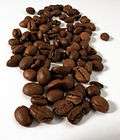Used coffee grounds


Used coffee grounds are the waste product from brewing coffee. In the late 19th century, used coffee grounds were used to adulterate pure coffee.[1] In gardens, coffee grounds may be used for composting or as a mulch[2] as they are known to slowly release nitrogen into the soil. The coffee grounds are rich in potassium, magnesium and phosphorus. They are especially appreciated by worms and acid-loving plants such as blueberries.[3] Gardeners have reported the use of used coffee grounds as a slug and snail repellent,[2][4] but this has not yet been scientifically tested. Some commercial coffee shops run initiatives to prevent the grounds from going to waste, including Starbucks' "Grounds for your Garden" project,[5] and community sponsored initiatives exist, such as "Ground to Ground".[6]
Used coffee grounds have other homemade uses in wood staining, air fresheners, and body soap scrubs.[2] They may also be used industrially in biogas production or to treat wastewater.[7]
See also
References
- ↑ Pendergrast, Mark "Uncommon grounds : the history of coffee and how it transformed our world" 2010 Basic Books. ISBN 978-0-465-02404-9
- 1 2 3 "Don't Throw Out Your Leftover Coffee Grounds!". Huffington Post. 4 August 2014. Retrieved 25 December 2014.
- ↑ Martin, Deborah L; Gershuny, Grace, eds. (1992). "Coffee wastes". The Rodale book of composting. Emmaus, PA: Rodale Press. p. 86. ISBN 978-0-87857-991-4. Retrieved January 5, 2010.
- ↑ "NORTH COAST GARDENING: Winter vegetable growing". Eureka Times-Standard. 24 December 2014. Retrieved 25 December 2014.
- ↑ "Coffee for Your Plants? Starbucks Offers Free Coffee Grounds for Gardeners". Starbucks.com. Retrieved December 13, 2015.
- ↑ "About Us | Coffee Grounds to Ground". Groundtoground.org. Retrieved October 26, 2011.
- ↑ Chalker-Scott, Ph.D, Linda (2009). "Coffee grounds— will they perk up plants?" (PDF). Master Gardener. Puyallup Research and Extension Center, Washington State University. Retrieved 25 December 2014.
